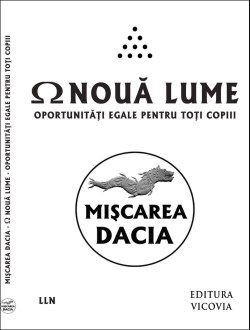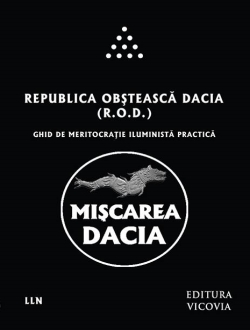 Vă invit să vă alăturaţi grupului Facebook Mişcarea DACIA, ce-şi propune un alt fel de a face politică!
Vă invit să vă alăturaţi grupului Facebook Mişcarea DACIA, ce-şi propune un alt fel de a face politică!Citiţi partea introductivă şi proiectul de Program, iar dacă vă place, veniţi cu noi !
O puteţi face clicând alături imaginea, sau acest link
Archive for the ‘Dacia Iluministă’ Category:
Other Directed
„According to Riesman, most people in the modern world are “other-directed”. The greatest influence in their lives is their peer group. They have no core values and follow whatever is in vogue at a particular moment. Their stance could flip from one moment to the next depending on the people around them. As Riesman wrote, “The other-directed person wants to be loved rather than esteemed.” They want to relate to others and be in emotional accord with them. They are the typical employees of large corporations – malleable, compliant, docile, easily controlled, willing to perform the humiliating 9-5 routine indefinitely. They are too busy interacting with their peers to worry about bad government, conspiracies, unlawful and unmerited authority. In other words, they
are suckers, willing to tolerate any nonsense so long as it doesn’t threaten their position in their peer group. They will join popular, trendy protest groups providing their friends are doing the same.
Anxiety, rather than guilt, is their main affliction. They are a herd, a flock, moving in whatever random direction the most purposeful of them has chosen to go in at a particular moment. They’re highly impressionable and gullible, perfect victims for advertising manipulation and the latest fads.
Fundamentally, they are rudderless, have no internal values, are continually buffeted by the winds of fashion. Deep down they are profoundly lonely and in constant need of others to give them a
sense of purpose. These people are Riesman’s “lonely crowd.” They are the perfect members of a consumer society, and have little to offer in the way of creativity, spiritual awareness, or human
greatness.
On the Internet, they inhabit FaceBook, MySpace, Bebo. Social Networking sites were made for them.”

Tags: other directed
Awakened
Să fii Treaz într-o Lume Nebună este atât o binecuvântare, cât şi un blestem. Trăim într-o Lume Nebună guvernată de Oameni Nebuni cu obiective nebuneşti, dar probabil că o să mă facă nebun dacă spun că asta e o nebunie. Oamenii pot să-mi spună „Nebun”, de vreme ce cred că mă vor numi „Drept” în final… dar va fi prea târziu.

To Be Awake In An Insane Nation Is Both A Blessing And A Curse. We Live In An Insane Nation Ruled By Insane People For Insane Objectives, But I’m Likely To Be Called Insane For Saying It, And That’s What’s Insane About It. People can call me “Crazy”, as I think I’m going to be called “Right” in The End, but then it will be too late.
Music
L-Y-R-I-C-S: FACE OUR TIME
Beyond the shine of bling bling
Your house your car your boat
You camouflage your unsureness not to be enough
Beyond material values
Your house your car your boat
You camouflage your deeply fears
Face-lifting liposuction
Alright I pay my new life
So sick
This way to kill our dreams
Let’s fight this fuckin’ shit
Face our time
This is where we live
For every fucking diamond and every fucking coat
You loosing basic values
Supporting poverty
Because (that’s why) your wealth (we fight)
Was made on human backs
And your achievement your success
Is nothing more than human beings’ blood
We’re spending so much time
To build up our life
On artificial values
Face our time
Your house your car your boat
Your house your car
Fuck you
It’s our frustration and aggression
(fight)
Tags: Music
Hyperian History Of The World (18th Century, Part 3)
Brice Merci
Iniţiator de conversaţii · 1 oră
Hyperian History Of The World (18th Century, Part 3)
The philosophy of the British empiricists in the 18th century as well as that of Immanuel Kant suffered from a lack of mathematics. Leibniz had been more than aware that his philosophy required further mathematical rigour in order to escape from the mire of metaphysical interpretations and attain to the purest of reason. Unfortunately, the 18th century represents the fracture of intellectual pursuits which we still see to its extreme in the academic world today. Leibniz had been a great polymath, excelling in all manner of disciplines and combining them all together in order to further his own understanding of everything. Newton, on the other hand, had been a great mathematician and scientist, but had had little philosophical understanding, thus failing to see the contradiction of combining empiricism with rationalist mathematics. The British empiricists were the opposite of this, great philosophers but with little mathematical knowledge.
This problem is also shown by looking at the mathematicians of the 18th century. Whereas Leibniz had been a great mathematician as well as a great philosopher, who had pioneered new mathematical disciplines in order to express his philosophy mathematically, the mathematicians who followed him and built on his work were great mathematicians but were not philosophers. Therefore, although they provided great mathematical insights which would have helped Leibniz enormously, no philosophers of the time thought to utilise their work.
The greatest mathematician of the 18th century was Leonhard Euler. Euler made major developments in almost all areas of mathematics, from trigonometry and calculus to algebra and geometry. Building on Leibniz’s pioneering work in calculus, Euler made major developments to analysis and power series. He also discovered the base of the natural logarithm, a number which is still known as ‘Euler’s number’, or just ‘e’.
Using this number, Euler explored ways of expressing logarithms with power series and then began to utilise complex exponentiation, utilising the imaginary constant, ‘i’. Through this work, Euler discovered an astonishing result. The power series expressions for exponential functions simplified to expressions which Euler noticed were equal to trigonometric functions. Amazingly, he realised that when ‘e’ was raised to an imaginary power, the result was equal to the sum of the cosine function and the sine function with an imaginary coefficient. His remarkable formula is expressed as: ‘e^ix = cos x + i sin x’.
For mathematicians, this was an exciting result, although they only saw it in terms of the abstract mathematics that they were studying. Philosophers, who ought to have realised the true implications of this formula, were either ignorant or indifferent to these mathematical developments. Leibniz may well have made the connection, but, alas, he was long dead before Euler made this discovery. Yet this formula, and what it revealed, was exactly what Leibniz had been seeking in his pursuit of the mathematics necessary to underpin his philosophy.
Euler knew his discovery was astonishing, yet even he did not realise just to what extent. Unbeknownst to him, Euler had in fact discovered the mathematical expression of the most very basic element of reality, the ‘arche’ of the ancient greeks, the foundation upon which all of reality is built. Unfortunately it would take centuries before this was realised by anyone, after further developments in mathematics and philosophy and the combination of it all together by great, unknown geniuses working behind the scenes.
But back in the 18th Century the world was still very much awakening into a much more scientific outlook on things, with these developments in mathematics greatly assisting scientists in their empirical attempts to explain the world around them. If only the philosophers had made similar use of mathematics…
This mathematical shift in human thought of the time was also felt in other areas, most interestingly in music. In the previous century, baroque composers such as Monteverdi had taken music to new heights of creativity, peaking in opera, yet the 18th century would see music taken much higher. It had been known since Pythagoras that music was a very mathematical discipline and the rules of harmony that had been established over the centuries could almost be said to obey mathematical laws, as if a composer could, in theory, compose beautifully harmonious music simply by making mathematical calculations.
This mathematical approach to music reached its zenith in the late baroque in the first half of the 18th century, chiefly in the work of its key composers, the Italian Antonio Vivaldi, and the Germans, Georg Frideric Handel and, greatest of all, Johann Sebastian Bach. Handel, who ended up based in London, wrote many operas and other concert works, yet his specialism was the sacred Oratorio, a format in which Handel was able to combine operatic solos, complex, contrapuntal orchestral passages and huge, glorious choruses.
Handel’s ideas were best realised in his monumental oratorio ‘Messiah’. Although ostensibly a christian work celebrating Jesus Christ, this was really a transcendent work, one whose biblical text is arranged in such a way as to abstract the christian message so that it can easily be reinterpreted in a spiritually uplifting way, with the concept of the ‘messiah’ being viewed as a divine state which we can all attain, and which Handel gives us a glimpse of in musical form. After composing the famous ‘Hallelujah’ chorus, the work’s emotional high point, Handel was found in his study in an almost trance-like state and, once roused, he gestured at the score and stated, “I thought I saw the face of god!”
While Handel became the most famous composer in Europe, his great contemporary, Johann Sebastian Bach was a much more esoteric composer, keeping himself shut up in his little german church playing the organ and composing a huge body of amazingly complex works. His compositions took the art of harmony and counterpoint to perhaps their greatest heights. Whilst most composers occasionally composed two melodies playing together to give a little colour to the music, Bach took counterpoint to extremes, often having, three, four, five, even six melodies all playing at the same time yet without losing the sense of perfect harmony. Listening to some of Bach’s contrapuntal works is almost like listening to the sound of beautiful mathematical equations in operation.
But, like Handel, Bach also composed large-scale sacred works. His greatest oratorio, the St Matthew Passion, is an intense, deeply powerful work in which Bach throws everything he has into the mix, creating a musical extravaganza even more complex and varied than any opera of the time. This work was surpassed in his later, greatest masterpiece, the Mass in B minor, completed shortly before his death in 1750. Alas, Bach, who perhaps had the most complete grasp of musical theory of any composer of all time, surely one of the greatest musical geniuses of all time, was not very popular during his life and it took several centuries for his greatness to be appreciated and for him to be placed in the highest pantheon of composers, where he truly belongs.
Bach and Handel brought the long Baroque age of music to a close. Following their complex and heavily ornamented music, composers began to streamline their music, creating a wonderfully elegant style which we know today as the ‘classical’ period. In this period, opera was reformed by the works of Christoph Gluck and many of the great musical forms, such as the concerto, the string quartet, and especially the symphony, were perfected by Austrian composer Franz Josef Haydn.
Haydn’s beautiful compositions were seeing him well on his way to becoming the most famous composer since Handel, but then his genius was soon eclipsed by a mere child, a prodigy who would take the musical world by storm unlike anyone else had ever done or has ever done since, Wolfgang Amadeus Mozart.
Mozart was perhaps the most naturally gifted musician of all time. He began to play the piano at the age of three and was composing melodies at five. His father began parading him around Europe giving concerts to the astonishment of all who saw him. At eight he wrote a symphony and at fifteen, a full opera. Mozart soon became famous all over Europe as a composer as well as a performer, becoming the greatest virtuoso pianist of the time. After settling in Vienna in 1782, Mozart took his composing to its greatest heights with his great operas, The Marriage Of Figaro, Don Giovanni and the wonderfully esoteric The Magic Flute. He also composed grand symphonies, eclipsing Haydn’s work in that genre and his piano concertos would draw huge crowds who were amazed by Mozart’s elegant composition as well as his stunning ability to improvise on the themes of the works.
In 1791, Mozart was commissioned by a mysterious unknown source to compose a Requiem mass. After having scored a little over half of the work, Mozart tragically died at the age of just thirty five, leaving one of his students to complete the great Requiem, perhaps the greatest choral work since Bach. In his short life Mozart composed a huge amount of music, seemingly able to churn out beautiful compositions without really trying. When he did try, however, his music achieved true glory, with levels of beauty and elegance never matched by anyone else, a huge amount of passion and also a great sense of humour. Mozart eclipsed every one of his contemporaries, even the great Haydn, who reemerged only after Mozart’s death to compose his greatest work, the oratorio The Creation.
The music of the great composers of the 18th century is the perfect soundtrack to the enlightenment values of the time and the scientific and mathematical advances that were being made resulting in some of the greatest artistic creativity since the renaissance. Yet towards the end of the century, political events would occur which would cause a great shift in human consciousness, resulting in a new age of passionate and romantic creativity. Music had become a powerful force in the world, which was able to bask in the transcendent glory of the genius of Handel, Bach, Haydn and Mozart.
/https://www.facebook.com/equazionedirac/videos/371012500231604/

Cioran
Oamenii sănătoși, normali, mediocri nu pot experimenta nici agonie, nici moarte. Trăiesc ca și cum viața ar avea un caracter definitiv. Este o parte integrantă a echilibrului superficial al oamenilor normali pentru a lua viața independent de moarte și a considera moartea ca o realitate care transcende viața. De aceea, ei percep moartea ca venind din afară, nu ca o fatalitate interioară a vieții în sine. Una dintre cele mai mari amăgiri ale omului obișnuit este să uiți că viața este prizonierul morții. Revelațiile metafizice încep numai atunci când echilibrul superficial al unuia începe să se dezlănțuie și o luptă dureroasă este înlocuită de spontaneitatea naivă. Presimțirea morții este atât de rară la oamenii obișnuiți, încât practic se poate spune că nu există. Faptul că presimţirea morții apare numai atunci când viața este zgâlţăitătă
din temeliile sale, dovedește dincolo de îndoială, imanența morții în viață. O perspectivă asupra acestor adâncimi ne arată cât de iluzorie este credința în integritatea vieții și cât de bine a întemeiat credința într-un substrat metafizic al demonismului.
Extras din On The Heights of Dispair de E. M. Cioran

Healthy, normal, mediocre people cannot experience either agony or death. They live as if life had a definitive character. It is an integral part of normal people’s superficial equilibrium to take life as absolutely independent from death and to objectify death as a reality transcending life. That’s why they perceive death as coming from the outside, not as an inner fatality of life itself. One of the greatest delusions of the average man is to forget that life is death’s prisoner. Metaphysical revelations begin only when one’s superficial equilibrium starts to totter and a painful struggle is substituted for naive spontaneity. The premonition of death is so rare in average people that one can practically say that it does not exist. The fact that the presentiment of death appears only when life is shaken to its foundations proves beyond doubt the immanence of death in life. An insight into these depths shows us how illusory is the belief in life’s integrity and how well founded the belief in a metaphysical substratum of demonism.
Excerpt from On The Heights of Despair by E. M. Cioran
Artwork by Eric Lacombe











